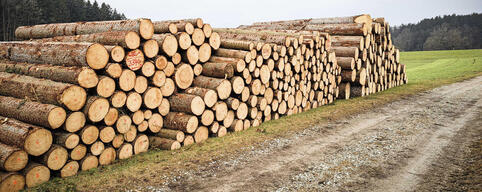

In recent months, the wood sector in Italy has seen a significant increase in the cost of materials, mainly due to trade tensions between the United States and China. This increase in wood prices, equal to about 15% in the first three months of the year, has put pressure on Italian companies operating in the wood-furniture sector. The growing volatility in international markets has made it clear that it is important to strengthen the internal supply chain and reduce dependence on imports.
Although Italy has significant forestry resources, it is highly dependent on imported wood from abroad. Currently, about 80% of the wood used in industry comes from other countries, highlighting a vulnerability that can be particularly critical in times of international tension. This imbalance is at the centre of the sector's concerns, which believes it is essential to invest in the valorisation of national resources.
A figure that further emphasises this issue is the current exploitation of Italian forest resources, which is less than 40% of the annual increment. This means that more than half of the growth potential of Italian forests is not being utilised, representing a lost opportunity both in economic and environmental terms. The untapped potential of Italian forests could offer a sustainable solution to the supply difficulties currently affecting the sector.
The situation requires careful consideration of how to incentivise the exploitation of national forest resources, while ensuring environmental sustainability. A strategy is needed that not only promotes the consumption of local timber, but also ensures that such exploitation is ecologically responsible.
The wood-furniture sector has already started to ask for specific political interventions to improve the self-sufficiency of the sector. Among the proposed measures are incentives for the utilisation of local timber, the creation of controlled and certified supply chains, and the introduction of tax breaks for companies that commit to reducing their dependence on imports.
With the election of Claudio Giust as the new president of Assolegno, there is a renewed push to enhance the national supply chain through investments in new technologies and the creation of consortia to support small and medium-sized enterprises (SMEs) operating in the sector. The aim is to create a network of collaborations that can facilitate access to markets and improve the competitiveness of Italian companies at an international level.
The implications of the international context, in this case the tariff war between the United States and China, show how much the global economy can influence local markets. The rise in prices is just one symptom of a wider problem, which concerns the stability of supplies and the ability of companies to adapt to changing market conditions.
Companies in the sector are therefore calling on institutions to intervene at both national and regional level, to address these challenges and stimulate the use of internal resources. Optimising the local supply chain could not only reduce costs, but also create new jobs and encourage the development of environmentally friendly technologies.
In conclusion, while the wood sector in Italy faces uncertainties related to the international market, the need for greater self-sufficiency and efficient management of national resources is becoming increasingly urgent. With a joint commitment from companies and institutions, the country could not only solve its current problems, but also lay the foundations for sustainable and long-lasting economic growth.



